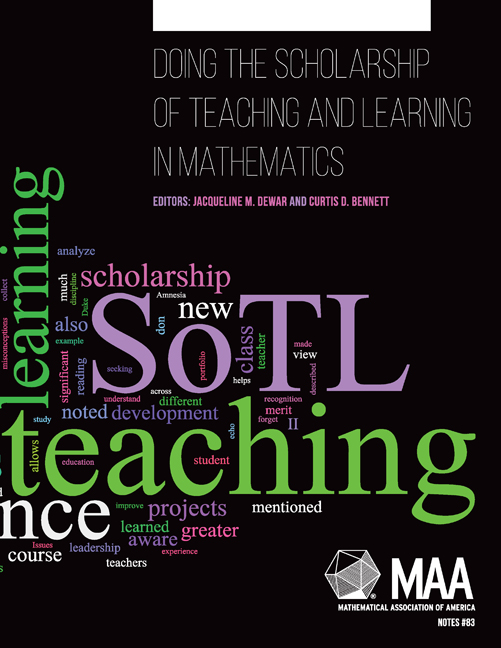Book contents
- Frontmatter
- Contents
- Foreword
- Preface
- Part I Getting Started in SoTL as a Mathematician
- Part II Illustrations of SoTL Work in Mathematics
- Theme 1: Experiments with Approaches to Teaching
- 5 Assessing the Effectiveness of Classroom Visual Cues
- 6 (Re)discovering SoTL Through a Fundamental Challenge: Helping Students Transition to College Calculus
- 7 A Quantitative and Qualitative Comparison of Homework Structures in a Multivariable Calculus Class
- 8 Playing Games to Teach Mathematics
- 9 Investigating How Students' Linking Historical Events to Developments in Mathematics Changed Engagement in a History of Mathematics Course
- Theme 2: Crafting Learning Experiences around Real-World Data or Civic Engagement
- Theme 3: Using Assigned Reading Questions to Explore Student Understanding
- Theme 4: Exploring Student Understanding of the Nature of Mathematics
- Theme 5: Tackling Large Questions
- Epilogue
- Index
8 - Playing Games to Teach Mathematics
from Theme 1: - Experiments with Approaches to Teaching
- Frontmatter
- Contents
- Foreword
- Preface
- Part I Getting Started in SoTL as a Mathematician
- Part II Illustrations of SoTL Work in Mathematics
- Theme 1: Experiments with Approaches to Teaching
- 5 Assessing the Effectiveness of Classroom Visual Cues
- 6 (Re)discovering SoTL Through a Fundamental Challenge: Helping Students Transition to College Calculus
- 7 A Quantitative and Qualitative Comparison of Homework Structures in a Multivariable Calculus Class
- 8 Playing Games to Teach Mathematics
- 9 Investigating How Students' Linking Historical Events to Developments in Mathematics Changed Engagement in a History of Mathematics Course
- Theme 2: Crafting Learning Experiences around Real-World Data or Civic Engagement
- Theme 3: Using Assigned Reading Questions to Explore Student Understanding
- Theme 4: Exploring Student Understanding of the Nature of Mathematics
- Theme 5: Tackling Large Questions
- Epilogue
- Index
Summary
Editors' Commentary
Edwin Herman's project was prompted by a desire to incorporate games as a learning device. This chapter details how the project unfolded in stages, because as he gathered evidence he kept refining his question. The first time he gathered evidence regarding whether the students enjoyed the activity. Next, he sought evidence of learning. Because of his knowledge of statistical methods he relied mostly on quantitative evidence. During the last iteration of the course, he became more interested in why game play might be having an effect, leading him to consider qualitative measures. Even readers having neither the interest nor the time to incorporate games in their teaching can learn about the process and the benefits of SoTL from this chapter.
Introduction
Think back to your earliest investigations into mathematical research. Not graduate school – long before that, when you were getting your first taste of exploring mathematics. For me, it was in high school – the idea of fractional derivatives (as opposed to partial derivatives). I had learned how to take a first derivative, and a second one, and so forth, but what about a half derivative? I worked mightily on the problem, struggling to define a formula for a half derivative that worked. Lacking the background needed to answer the question, I was ultimately unsuccessful in discovering a formula (or, rather, re-discovering it – papers and books have been published on fractional derivatives, though I did not find them until years later, in college). Although I lacked the tools and sophistication necessary to answer my question, the attempt taught me a lot about mathematical research and made me a better mathematician in the process.
When you start to embark on a project into the Scholarship of Teaching and Learning, it is worth keeping in mind the idea that the process of doing the research will teach you as you explore. As you progress, you will discover better ways to ask questions – even better questions to investigate. You may or may not succeed in answering your original question in a satisfying way, but you will become a better researcher, and a better teacher, because of it.
- Type
- Chapter
- Information
- Publisher: Mathematical Association of AmericaPrint publication year: 2014



